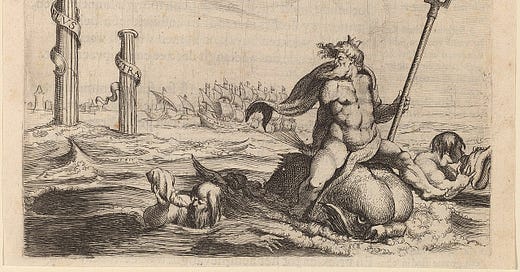Welcome to
. This post is part of our Strange Worlds series, where we look back at the unfamiliar landscapes of our planet’s past. For the full map of posts, see here.It is said that for his tenth labour, the Greek hero Heracles was tasked with stealing the cattle of Geryon, a three-bodied beast who lived at the far edge of the world. Out there, at the westernmost boundary of the Mediterranean Sea, the demi-god came upon a mountain that bridged the continents of Africa and Europe. Rather than cross over this ridge, Heracles simply smashed his way through it, cleaving a passage for himself, and water, to pass through. All that remained of the mountain were the twin sentinels of rock, known as the “Pillars of Heracles”, that have flanked the Strait of Gibraltar ever since.
Curiously, recent work in geology has revealed more truth to this myth than one might think.
In aeons past, all the land of the world was joined in a single supercontinent: Pangaea. As this great landmass began to break up some 200 million years ago, an expanse of water known as the Tethys Ocean split the once-single continent into two parts, called Gondwana and Laurasia. Over time, as these supercontinents fragmented further, the mighty Tethys grew narrower and narrower until the encroaching lands split it into three seas: the Mediterranean, the Indian Ocean, and the Paratethys Sea, which once extended from Romania to Central Asia.1
The world’s land and seas were now beginning to resemble something we might recognise — or, at least, they were until something remarkable happened. Some six million years ago, the African and Eurasian tectonic plates jolted together at their western edge, closing the Straits of Gibraltar to the Atlantic Ocean. The Mediterranean is a vast sea, but it doesn’t receive enough replenishment from the rivers that disgorge their waters along its coasts to account for the huge amount of seawater evaporating from its surface every day. Without the constant inflow of water from the Atlantic, the sea began to shrink.
It took only a thousand years for the glistening blue waters of the Med to all but disappear. If you had stood on the edge of that once-great sea, looking out, the landscape before you would have been unlike anything you’ve ever seen.






